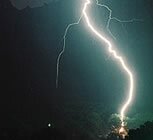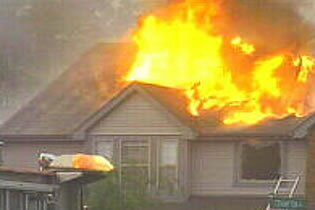 Since the invention of lightning rods by Ben Franklin in the mid 1700's, the technology of lightning protection has evolved to provide proven protection for our homes and businesses.
Since the invention of lightning rods by Ben Franklin in the mid 1700's, the technology of lightning protection has evolved to provide proven protection for our homes and businesses.
FACTS
- Lightning rods will neither attract nor repel lightning. They simply provide a pre-determined path of low resistance to the ground, where a harmless discharge takes place.
- A custom designed system may be concealed during construction or semi-concealed on existing buildings, thereby not interfering with the aesthetics of the architecture. Roof terminals are only 10" tall.
- Will give your family peace of mind, save money for costly repairs on the building and/or appliances, and increase the value of your home.
- Structural damage simulated in General Electric Laboratories showed that lightning caused metal to vaporize, wood to split, bricks & stones to burst, and concrete to shatter.
- Lightning protection systems today are constructed of durable materials. Maintenance is not required unless you make changes to the structure, the roof or add a satellite dish.
- Main components of lightning protection are:
- Air Terminals installed on roof ridges, dormer, chimneys, ventilators and other structures.
- Main Conductors are cables that interconnect the air terminals to grounds.
- Ground Terminations are typically copper or copper-clad rods driven into the earth approximately 2'-5' from the foundation and a minimum of 10' in depth.
- Bonding Connections are made to equalize the potential between grounded metal objects.
- Lightning Arresters protect wiring from lightning induced damage.
- Surge Suppressors may be added to further protect valuable electronic equipment.

FICTION
- A grounded home is protected against lightning strikes. Grounding only protects electrical safety.
- Our antenna is grounded. This is not meant to handle a lightning strike and allows dangerous current to enter the home.
- The trees surrounding our home are higher and will protect our home from strikes. Many times trees are struck and side flash to the house.
- Installing protection is a great "do it yourself" project. Your first clue that this is a bad idea should be that there aren't any Saturday morning classes at your local hardware store on this subject. A proper system takes into account your home's design, construction, electrical components, soil conditions and more. The tiniest spark from an improperly installed system could cause fire, death or injury.
- Lightning never strikes the same place twice. Since lightning results from a cloud-to-ground attraction, it only makes sense that the conditions causing the first strike, could produce another one.
- Surge arrestors and suppressors are already protecting my home. Surge suppressors are important components of a complete system, but can do nothing to protect a structure against direct lightning strikes. Arrestors must be installed in conjunction with a lightning protection system.
- Insurance will cover damages, so I'll take my chances. This is generally true for an initial occurrence; however, second and third claims may be denied. Non-renewal of policies has occurred after a lightning claim has been entered.
- I live in a low-lying area; I'm safe from lightning. False, all elevations are susceptible to strikes.